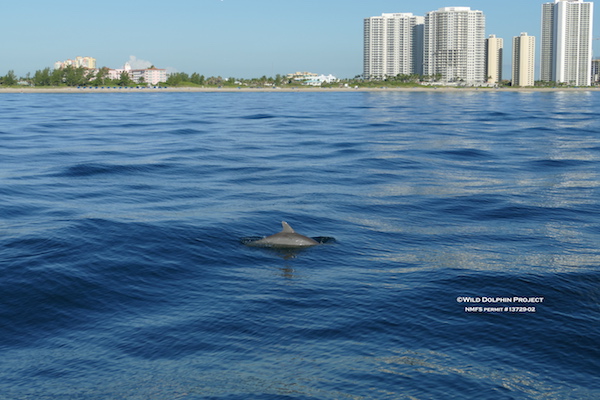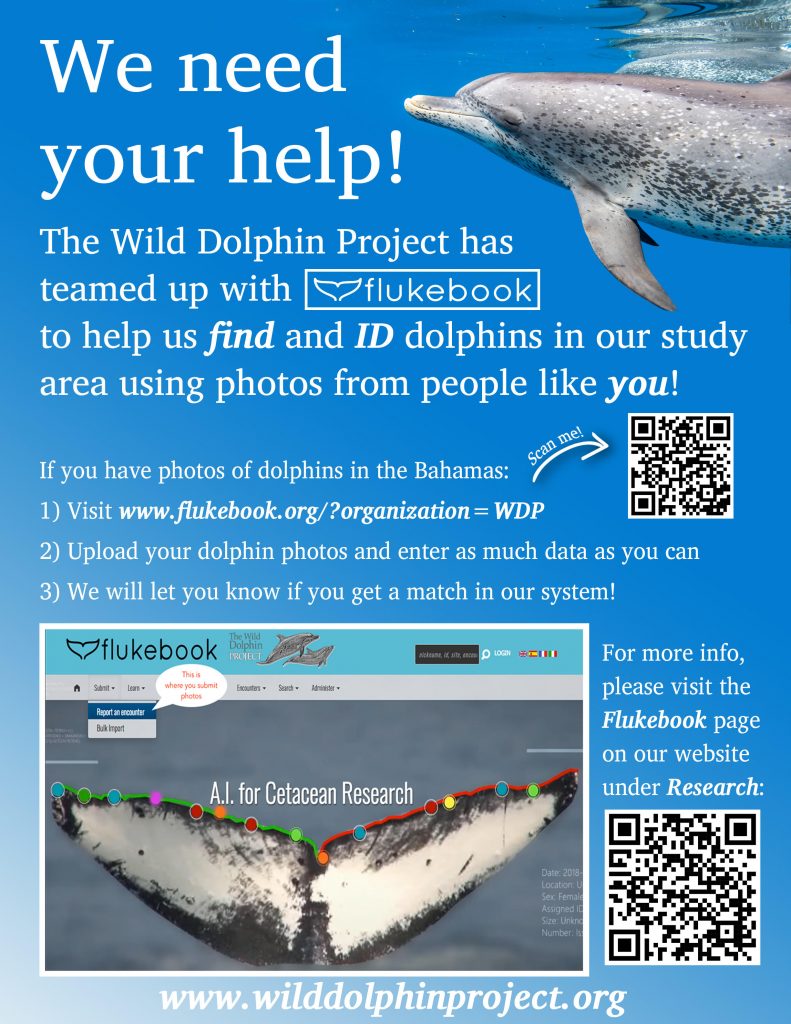
The South Florida coast where we survey for Florida dolphins. Photo Credit © Wild Dolphin Project
We study the dolphins at our longterm study site in the Bahamas during the summer months. That’s when weather and working conditions are best. During winter, our boat gets hauled out for a tune-up, while we analyze data to publish our scientific results, present at scientific conferences, give talks to the public and get ready for the next season!
In 2009, we started fieldwork in Florida over the fall and winter months to begin studying dolphins off the South Florida coast, as little is known about them. As we could, we would head out and survey along the coast to find either spotteds or bottlenose dolphins. Yet, between boat maintenance, weather and everyone’s schedules, finding time for surveys was a challenge. Now, we’re ramping up that work again and we can rely on citizen scientists to help us collect data.
Most of the work on dolphins in Florida is on bottlenose dolphins in the Sarasota Bay region, as well as in the Florida Keys, Florida Bay and Indian River Lagoon. With little known about the coastal populations, we want to document and monitor their abundance, distribution and residency patterns. We’re also curious if any Atlantic spotted dolphins cross the Gulf Stream from the Bahamas to Florida waters. This is why tracking individuals is important. So far we have never seen an individual in both areas. However, we do know they have traveled across deep water between islands in the Bahamas.
Florida Fieldwork
Our work in Florida is a little different than in the Bahamas, since it does not require us living out at sea. Typically, we leave the dock around 8 or 9 am on our 62ft power catamaran (R/V Stenella) and survey our permit area until at least 3 pm. We conduct surveys along the intracoastal and also out in the ocean close to shore and in deep water.
During our surveys, we always have someone on “Dolphin Watch” to scan for dolphins. We record environmental information every half hour. This environmental information includes our location, water temperature, sea state, wind direction, wave height, and cloud cover. If we spot dolphins we mark the time, location, water depth, and what species we saw. Then we take photo ID shots from the surface of the dolphins’ dorsal fins, which we are legally allowed to do with our NOAA Fisheries permit.
After the day out on the water, our research assistant Cassie Rusche make copies of our data sheets and puts the photos onto the computer to be analyzed.

Photo taken under NMFS permit, ©Wild Dolphin Project
FlukeBooks
Currently, Cassie is working with an intern, Liam Groth, to organize all the data from the Florida work, such as entering the sighting sheets into an electronic database, and starting to identify individual dolphins and build a catalog.
If you have been following our work you also know that we have teamed up with Flukebook. They are a company that uses computer algorithms to identify marine mammals from pictures sent in by citizens. “Flukebook is a platform for citizen scientists to help researchers by being their eyes out on the oceans,” says Cassie.
We originally partnered with Flukebook to help us find some of our missing dolphins over in the Bahamas. A lot of boaters and divers frequent our research areas and come across Atlantic spotted dolphins. To help our research, people can submit any photos they take to Flukebook and the computer uses algorithms against our uploaded catalog to see if there are any matches.
We are now trying to implement Flukebooks for our Florida work. Once Liam works through the photos and starts naming these individuals, Cassie will build an ID catalog in Flukebook for the Florida dolphins. With this information in Flukebook, if any citizens send us photos of dolphins she can put them in this platform and see if there are any matches to the dolphins we have identified. This will help us track animals without actually having to put tags on the animals.
‘The work I have been doing for The Wild Dolphin Project is quite extraordinary,” says Liam. “When I came in as an office volunteer I really didn’t know what to expect. That all changed when I opened up a laptop and saw thousands of photos of bottlenose and Atlantic spotted dolphins photographed off the SE Florida coast.” It’s a big job combing through years of unsorted and unlabeled dolphin photos – we’re lucky to have Liam.
If you see dolphins…
If you happen to see dolphins off South Florida, please respect the animals and give them some space. There are different distance requirements when viewing marine mammals from a boat for their safety and for yours, as they are protected under the Marine Mammal Projection Act.
For dolphins, stay at least 50 yards away. If the animals approach your boat and ride the bow, keep your speed even and do not make any sudden turns because the dolphins cannot adjust quickly while riding the bow wave and you may injure them with the boat. Try to keep your viewing time under 30 minutes and do not encircle or harass the animals. Most importantly, please remember these are wild animals trying to live their lives and survive. We know it’s an awesome experience to see these animals, but most importantly we do not want to cause them any harm!
Additionally, please feel free to contact us and let us know where you saw them. We keep track of any sightings and this helps us in our research. You can email our research assistant, Cassie Rusche, at cassie@wilddolphinproject.org and let her know. Any information you can provide is greatly appreciated. Some of the things we are looking for are the following: location, the species you saw, group size, and time of day.

